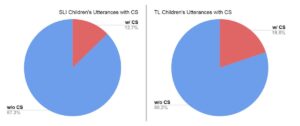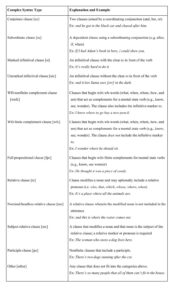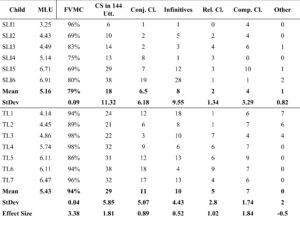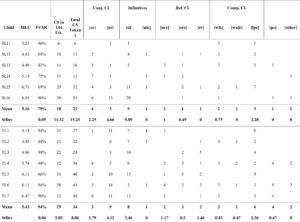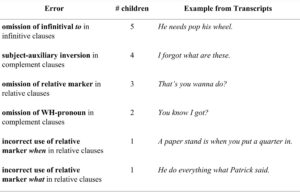The Production of Complex Syntax in Five-Year-Old Children with Specific Language Impairment
ABSTRACT
Children with specific language impairment (SLI) have been shown to have deficits in complex syntax (CS) production, but a complete understanding of the production of complex syntax in children with SLI has yet to be achieved. It is especially important to understand SLI as a whole because children with SLI tend to face lower outcomes in their adult life. This study builds on extant literature by analyzing the production of complex syntax in five-year-old children with SLI in comparison with their typically developing peers. Thirteen children were included in this study, six with SLI and seven with typical language (TL). Language samples from these two groups were transcribed, reviewed, and coded for complex syntax and grammatical morphology. Children with SLI were found to have a significantly lower finite verb morphology composite (79% versus 94%), less CS production (18 versus 29 instances), less CS types production (22 versus 34 instances), and a greater proportion of simpler complex syntax types. Children with SLI were also found to have errors within complex syntax structures, such as the omission of the infinitival to in infinitive clauses. Understanding the makeup of complex syntax will allow for the creation of more successful intervention methods.
INTRODUCTION.
Children with specific language impairment (SLI) are characterized as having difficulty with acquiring and developing spoken and written language. There is no clear cause for this impairment, as children with SLI show normal hearing, normal scores on nonverbal intelligence tests, and no evidence of neurological impairment [1].
The hallmark deficit in children with SLI lies in morphosyntax; children often omit grammatical morphemes (e,g, the infinitival to, I have to run there), particularly morphemes that mark tense and agreement, long after their typical peers have mastered them, and the omission occurs inconsistently [2, 3]. Children with SLI can have deficits in of other language areas as well, such as word learning, but deficits in morphosyntax are most consistent among children with SLI [2]. An example of an issue in morphosyntax is the omission of the obligatory past tense -ed after verbs (e.g. I walk to the store yesterday versus I walked to the store yesterday).
The language difficulties that children with SLI experience extend beyond early language development, continuing to manifest into adulthood [1]. Children with SLI often face poorer educational outcomes, lower reading skills, and difficulty with psychosocial factors [4]. Thus, it is absolutely necessary to understand the complexities of SLI at an early age, in particular complex syntax (CS).
CS captures the production of clausal coordination and subordination without the explicit reproduction of grammatical structures like the speaker’s matrix or main clause. If only sentence-level utterances are considered, much of children’s production of dependent clauses in spoken language will likely be missed. Thus, rather than use complex sentences as a measurement of advanced speaking, CS is used. In CS, the utterance is the unit of spoken language instead of the sentence to account for the elided productions made in spoken language.
CS is a relatively new area of inquiry. The few studies on CS in children with SLI have generally found that children with SLI begin developing CS later than same-age peers, are less proficient in CS than same-age peers, combine CS types less than same-age peers, and omit grammatical markers essential to some CS types [5,6]. Furthermore, children with SLI use fewer CS structures in spoken language [7].
The nature of CS in five-year-old children with SLI is of interest. This age group was chosen because evidence suggests that it is at five years of age that children with SLI start using a more varied production of CS that expands beyond the earliest emerging types (i.e. let’s clauses, reduced infinitives, simple infinitives [5,7].
The study addresses the question: What is the nature of complex syntax produced by children with SLI who are five years of age? We hypothesized that five-year-old children with SLI will produce the earliest emerging types of CS (coordinating clauses and simple infinitives) and will produce less of later-developing types of CS (complement clauses, relative clauses, and participle clauses) as compared to typically developing children of the same age.
MATERIALS AND METHODS.
Participants.
Thirteen children were included in this study. The children’s language samples and data were accessed from two extant databases. The language samples were collected as part of unpublished studies conducted in the Child Language and Literacy Lab at Vanderbilt University (2201 West End Ave, Nashville, TN 37235). The data was collected from children with SLI in 2006-2009 and children with TL in 1999-2002.
Six children with SLI were included in this study. The group comprised four boys and one girl who ranged from 4;8 (4 years, 8 months) to 5;4 years old. Children with SLI were administered the Test of Language Development-Primary (TOLD-P) as a test to measure the language deficits in these children and The Columbia Mental Maturity Scales (CMMS) as a test to measure nonverbal intelligence. Children with SLI averaged a 70.25 on the TOLD-P and a 95.8 on the CMMS. The Mean Length of Utterance in Morphemes (MLUM) and the Finite Verb Morphology Composite (FVMC) were also calculated. FVMC is a percentage derived from the total number of correct uses of finite verb morphology over all the uses of finite verb morphology in the child’s utterances in a transcript. The MLUM for children with SLI was 5.16 (SD = 1.42) and the FVMC was 79% (SD = 10%).
Seven children with TL were used as a comparison group. The group comprised three boys and four girls who ranged from 5;0 to 5;9. Not much is known on how gender affects complex syntax, however understanding any potential effects of gender is beyond the scope of this experiment. Children with TL were administered the Structured Photographic Expressive Language Test (SPELT) to measure their expressive morphosyntactic skills and the CMMS to verify that there was no intellectual disability. Children with TL had an average of a 48th percentile on the SPELT and averaged a score of 106 on the CMMS. The MLUM and FVMC were also calculated for children with TL to be 5.43 (SD = 0.93) and 94% (SD = 5%), respectively.
Procedure.
The language samples were collected using the Hadley Interview Protocol for Eliciting Text-Level Discourse [8]. A play-based language sample collection protocol was administered to the children who did not elicit enough language with the Hadley Protocol.
Language samples from unpublished previous studies had been transcribed by a research assistant and were reviewed by other research assistants. For this study, the transcripts were coded for CS and reviewed to align with newer transcription and coding conventions [9]. The lab director reviewed each transcript one final time for reliability purposes.
Grammatically similar CS clause types were combined to create three CS composites. The conjoined clause composite consisted of coordinating clauses and subordinating clauses; the infinitive composite consisted of simple infinitives and unmarked infinitives; the relative clauses composite consisted of subject relative clauses, nominal relative clauses, and other relative clauses; and complement clauses consisted of full propositional complements, WH-finite complement clauses, and WH-nonfinite complement clauses (Table S1).
The transcripts were coded for types of CS. The types of CS include the following: conjoined clause (cc), subordinate clause (sc), marked infinitives (si), unmarked infinitives (uic), WH-nonfinite complement clause (wnfc), WH-finite complement clause (wfc), full propositional clause (fpc), relative clause (rc), nominal relative clause (nrc), subject relative clause (src), participle clause (pc), and other (oth) (Table S2). For clarification, a WH-clause includes a WH-word such as what.
Data Analysis.
The data were processed utilizing the Systematic Analysis of Language Transcripts (SALT) software. The transcripts were examined for MLUM within 100 utterances. FVMC was analyzed within the entire transcript. statistics are reported along with effect size, Cohen’s d, to examine differences between the two language groups. Complex syntax, CS types, and CS tokens (the frequency of each CS type irrespective of [cs] coding) were analyzed in 144 complete and intelligible utterances per child.
RESULTS.
Children with SLI were less likely to produce CS than children with TL. Children with SLI produced 7.1% fewer utterances that contained CS than children with TL (Figure 1). Whereas children with TL had an average of 19.8% of utterances containing CS, children with SLI had an average of 12.7% (Figure 1). Children with SLI had an average of 18.0±11.3 CS utterances in 144 utterances, whereas children with TL had an average of 29.0±5.9 CS utterances in 144 utterances (Table 1). The effect size for this difference was very large at 1.81.
Figure 1. Utterances with CS in SLI versus TL children. Left: Children with SLI included CS in 12.7% of utterances (red) and did not include any CS in 87.3% of utterances (blue). Right: Children with TL included CS in 19.8% of utterances (red) and did not include any CS in 80.2% of utterances (blue).
Table 1. Summary of Composite CS Differences between SLI and TL groups.
The children with SLI produced fewer mean tokens within each complex syntax composites compared to the children with TL. Children with SLI produced on average fewer coordinating clauses than children with TL (mean±SD, SLI: 6.5±6.2 vs TL: 11.0±5.1, effect size=0.89, Table 1). Children with SLI had a fewer average of infinitive clauses than children with TL (SLI: 8.0±9.6 vs TL: 10.0±4.4, effect size=0.52, Table 1). Children with SLI produced fewer average relative clauses than children with TL (SLI: 2.0±1.3 vs TL: 5.0±1.0, effect size=1.02, Table 1). Lastly, children with SLI produced on average fewer of complement clauses than children with TL (SLI: 4.0±3.3 vs TL: 7.0±1.74, effect size=1.84, Table 1). Overall, children with SLI were found to produce fewer overall CS tokens and fewer tokens within each CS composite than children with TL. Children with SLI produced an average of 22.0±16.3 instances of CS types compared to children with TL, who produced an average of 34.0±8.9 instances of CS types (Table 2).
Children with TL’s utterance composition was higher in every CS category except for infinitives (Figure 2). Children with SLI produced 11.9% more infinitives than children with TL (38.2% versus 26.3%) (Figure 2). However, children with TL produced 2.8% more conjoined clauses (32.6% versus 29.8%), 0.4% more complement clauses (19.5% versus 19.1%), 4.5% more relative clauses (14.4% versus 9.9%), and 3.1% more participle and other clauses (7.2% versus 3.2%) (Figure 2).
Figure 2. CS distribution in SLI versus TL children. Children with SLI had 29.8% conjoined clauses., 38.2% infinitives, 19.1% complement clauses, 9.9% relative clauses and 3.1% other. Children with TL had 32.6% conjoined clauses, 26.3% infinitives, 19.5% complement clauses 14.4% relative clauses, and 7.2% other.
Children with SLI produced earlier-developing CS types (i.e. coordinating conjunctions, simple infinitives, unmarked infinitives) at the same frequency as children with TL. Children with SLI produced a higher average of coordinating conjunctions at 4.0±2.3 instances as compared with children with TL at 3.0±1.8 instances (Table 2). Children with SLI also produced an average of 9.0±9.9 simple infinitives, whereas children with TL produced an average of 8±3.5 simple infinitives (Table 2).
Table 2. Summary of CS subtype differences between SLI and TL groups.
Children with SLI produced fewer subordinate clauses than children with TL, at an average of 3.0±4.5 instances as compared to 9.0±4.1 instances (Table 2). Children with SLI produced fewer relative clauses than children with TL. For example, children with SLI averaged a mean of 1.0±0.5 subject relative clauses, whereas children with TL averaged a mean of 3.0±0.5 subject relative clauses (Table 2). Children with SLI less consistently produced CS constructions. All seven children with TL produced full propositional complements, subordinate clauses, and simple infinitives, whereas children with SLI had a sparser distribution (Table S3).
DISCUSSION.
The aim of this study was to better understand the nature of CS in five-year-olds with SLI in comparison to five-year-old children with typical language.
CS in SLI children versus TL children.
Children with SLI used fewer instances of CS than children with TL. The difference of the means of 18 versus 29 CS in 144 utterances indicates that children with SLI are not producing as many instances of CS as their typical peers. The same trend can be found in CS tokens, where there is a difference of 22 and 34 tokens, respectively. Furthermore, the percent of utterances that included syntax in children with SLI was far less than children with TL. A greater portion of SLI children’s utterances should contain complex syntax, but they do not. This is consistent with findings of previous studies, which also found a difference in the production of CS in children with SLI [7].
Some of the children with SLI produced similar amounts and types of CS as children with TL; however, children with SLI used simpler CS types (i.e. coordinating clauses and infinitives). It is not too surprising that children with SLI produced simpler types at the same or greater frequency than children with TL because the structures are earlier emerging. However, once the attention shifts to later-developing CS types, the difference between the two groups becomes more apparent.
Children with SLI used fewer CS types than children with TL. Children with TL used a greater amount of CS tokens, 6.83 versus 8 mean number of different CS tokens; however, the difference is relatively small, suggesting that children with SLI and TL produce a similar number of CS types. Although the difference is minute, there. were several children in the TL group who used almost all the CS types, whereas most children with SLI were using below six of the thirteen CS types. Additionally, children with SLI collectively produced fewer instances of CS categories (i.e. conjoined clauses, infinitives, complement clauses, relative clauses, and other) than children with TL. These findings are supported by previous reports [7].
Most of the effect sizes for combined CS groups were large (conjoined clause, relative clause, and complement clause), indicating a large difference between the means of the SLI group and the TL group. This large difference sets the groups apart as a whole and provides further evidence that children with SLI produce complex syntax differently than their typical language peers.
Children with TL had a more equal distribution and higher frequency of later-developing CS types, such as the complement clause and relative clause. As a group, children with TL were all consistently producing the following structures: subordinating clauses, simple marked infinitives, and full propositional complements, whereas children with SLI were not. This finding indicated that children with SLI were developing these CS types at a slower rate than TL children and have not yet mastered them by age five.
The difference of 79% and 94% FVMC suggests that children with SLI are vastly lacking obligatory grammatical elements in their production of utterances. This aligns with the hallmark deficit in children with SLI, morphosyntax [1]. Furthermore, a large concentration of these errors lies directly within the complex syntax structures.
Previous studies have shown that children with SLI often omit grammatical morphemes on verbs in which the marking is obligatory, such as the third person singular -s, past tense -ed, infinitival to, WH-pronouns, and relative markers [1]. The results of the current study aligned with these findings.
Children with SLI were found to make errors within their complex syntax (Table S4). Children with SLI were found to omit the infinitival to, relative markers, and WH-pronouns and fail to use subject-auxiliary inversion (Table S4). Therefore, not only do children with SLI use less CS than typically developing peers, but they also struggle with the grammatical components necessary for CS structures.
Implications.
CS is crucial to children’s success in academic environments, where they are expected to efficiently produce CS types in written assignments and verbal communication. Creating interventions that target CS will ensure that children with SLI do not fall behind in their ability to engage in academic environments. However, it is important to note that interventions may not lead to absolute success but rather serve to reduce the impact of the problem with CS.
A better understanding of CS as an area of weakness for children with SLI will lead to improved diagnostic techniques as well as enhanced intervention methods to help increase CS production in In fact, just having the knowledge that children with SLI produce less CS than their typically developing peers and are less able to use more advanced CS types will allow speech-language pathologists to use existing techniques and make a concentrated effort to incorporate CS into their sessions.
Future Directions.
Future studies should focus on using a larger set of participants and statistical analysis to increase the robustness of the results. Additionally, the age range should be extended to include participants who have entered kindergarten to investigate if the difference in CS production between these two groups decreases or increases after shared educational experience.
ACKNOWLEDGMENTS.
I would like to thank Dr. C. Melanie Schuele for her abundant guidance and support throughout this endeavor, Ian Morton for his time and dedication in mentoring me, and the members of the Child Language and Literacy Lab for their support for my project and energy during Boggle games. Lastly, thank you to Dr. Lesa Brown and Dr. Campbell for their advice on the writing of my paper.
SUPPORTING INFORMATION.
Table S1. CS Types.
Table S2. Frequencies in Composite CS Types.
Table S3. Frequencies in CS Types.
Table S4. Errors in CS of SLI Children.
REFERENCES.
- L. B. Leonard, C. A. Miller, B. Grela, A. L. Holland, E. Gerber, M. Petrucci, Production operations contribute to the grammatical morpheme limitations of children with specific language impairment. Journal of Memory and Language. 43, 362-378 (2000).
- L. B. Leonard, Children with specific language impairment (MIT press, Cambridge, MA, 2014).
- M. L. Rice, K. Wexler, H. Hershberger, Tense Over Time: The Longitudinal Course of Tense Acquisition in Children with Specific Language Impairment. Journal of Speech, Language, and Hearing Research. 41, 1412-1431 (1998)
- K. L. Werfel, A. E. Hendricks, C. M. Schuele, The potential of past tense marking in oral reading as a clinical marker of specific language impairment in school-age children. Journal of Speech, Language, and Hearing Research. 60, 3561-3572 (2017).
- C. M. Schuele, J. C. Dykes, Complex syntax acquisition: a longitudinal case study of a child with specific language impairment. Clinical linguistics & phonetics. 19, 295-318 (2005).
- C. M. Schuele, L. Tolbert, Omissions of obligatory relative markers in children with specific language impairment. Clinical Linguistics & Phonetics. 15, 257-274 (2001).
- K. B. Arndt, C. M. Schuele, Multiclausal utterances aren’t just for big kids: a framework for analysis of complex syntax production in spoken language of preschool-and early school-age children. Topics in Language Disorders. 33, 125-139 (2013).
- P. A. Hadley, Language sampling protocols for eliciting text-level discourse. Language, Speech, and Hearing Services in Schools. 29, 132-147 (1998).
- C. M. Schuele, Complex syntax coding manual (Unpublished coding manual, Vanderbilt University, Nashville, TN, 2009).
Posted by John Lee on Tuesday, December 22, 2020 in May 2019.
Tags: complex syntax, SLI, specific language impairment, typical language

